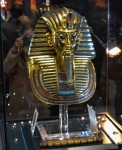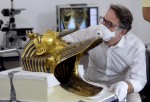 The gold funerary mask of Tutankhamun has gone back on display at the Egyptian Museum in Cairo after two months of restoration to repair a botched reattachment of its false beard. The beard fell off last summer when the mask was returned to the display case after workers replaced a burned out light bulb. Anxious to get the mask back on display as quickly as possible, museum staff hastily reattached the beard with a sloppy thick application of epoxy that hardened into an unsightly layer.
The gold funerary mask of Tutankhamun has gone back on display at the Egyptian Museum in Cairo after two months of restoration to repair a botched reattachment of its false beard. The beard fell off last summer when the mask was returned to the display case after workers replaced a burned out light bulb. Anxious to get the mask back on display as quickly as possible, museum staff hastily reattached the beard with a sloppy thick application of epoxy that hardened into an unsightly layer.
 When the news got out a few months later, at first museum officials denied any damage had happened before admitting that someone had blundered. They brought in a team of German and Egyptian restorers led by Christian Eckmann and secured a donation of 50,000 euros from the German Foreign Ministry to fund the restoration. After months of analysis and preparation, work began on the mask this October.
When the news got out a few months later, at first museum officials denied any damage had happened before admitting that someone had blundered. They brought in a team of German and Egyptian restorers led by Christian Eckmann and secured a donation of 50,000 euros from the German Foreign Ministry to fund the restoration. After months of analysis and preparation, work began on the mask this October.
Researchers took the opportunity to study the mask thoroughly. It was 3D scanned and examined inside and out with a microscope in the hope that it might answer some questions about its composition, like what materials and techniques were used to put it together, and whether there is any evidence supporting the theory most recently proposed by British Egyptologist Nicholas Reeves that the mask was first made for Queen Nefertiti and then hastily modified for Tutankhamun after his unexpected death at age 19.
 The biggest challenge was determining how best to remove the epoxy layer to liberate the false beard from its clumpy prison. Restorers wound up sticking with simple tools that would have been available to the original makers in 1,324 B.C.: wooden tools and heat. The adhesive was slightly warmed to soften it and then removed by careful scraping with the wooden sticks, spatulas and other tools which are soft enough they won’t scratch the gold. It took two weeks to remove the beard and another six to figure out how best to reattach it in a responsible, reversible way.
The biggest challenge was determining how best to remove the epoxy layer to liberate the false beard from its clumpy prison. Restorers wound up sticking with simple tools that would have been available to the original makers in 1,324 B.C.: wooden tools and heat. The adhesive was slightly warmed to soften it and then removed by careful scraping with the wooden sticks, spatulas and other tools which are soft enough they won’t scratch the gold. It took two weeks to remove the beard and another six to figure out how best to reattach it in a responsible, reversible way.
Egypt’s Antiquities Minister Mamdouh el-Damaty said the reattachment came after studies explored the best materials to use for the work.
“We indeed found them to be the natural materials which the ancient Egyptian used; they are still the best tools: beeswax,” el-Damaty told reporters in Cairo on Wednesday. “It was prepared well and the beard was attached very successfully.”
The false beard wasn’t really attached when Howard Carter discovered the tomb in 1922. It looked like it was in place, but the support had broken in antiquity so when Carter moved the mask it was in two pieces. The mask and beard were displayed separately until 1946 when for the first time he beard was glued in place. That wasn’t the only time glue was used. Restorers found multiple thin layers underneath the epoxy one. The restoration team will publish a full report of the analysis, study and restoration of the mask and beard.